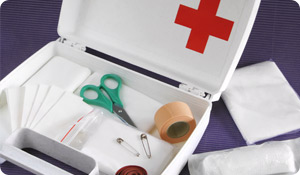
What's one thing you never want to leave home without? A first-aid kit. When scrapes, stings, bumps, and boo-boos happen, make sure you have what you need to treat the injury right away.
The American Red Cross offers a complete line of kits you can slip in your pocket, pack in your purse, or stow in the trunk of your car. So, what are the five essential items everyone should carry?
1) Hand sanitizer. Clean your hands before and after you administer first-aid to avoid contaminating the wound or infecting yourself.
2) Antiseptic cleansing wipes. Alcohol swabs will do in a pinch, but they can painfully sting on an open wound. Instead, use sting-free antiseptic wipes that contain Benzalkonium Chloride. They clean gently and while they're no substitute for thorough washing with soap and water, they'll help eliminate some of the dirt, germs, and debris that might settle into a wound.
3) Tweezers. When you're faced with splinters, stingers, broken glass, and other nasty, little wound-makers, you need the right tool for the job. Fingernails don't usually work and may push germs into the wound. Pack a tiny pair of tweezers to grab that pesky thing and yank it out. Follow up with antiseptic cleansing and a bandage.
4) Bandages. It's best to pack a variety of bandages in sizes and styles. Here's what the American Red Cross includes in their pocket-pack first aid kit:
- 5 Adhesive plastic bandages, ¾" x 3"
- 3 Adhesive fabric bandages, ¾" x 3"
- 5 Junior adhesive plastic bandages, 3/8" x 1-1/2"
- 1 Fingertip fabric bandage
- 1 Knuckle fabric bandage
5) Pain reliever. Aspirin and ibuprofen are excellent for treating minor pain, plus they're great anti-inflammatory agents that reduce swelling, fever, headache,s and other aches and pains.
Store these essential five in a zip-lock bag and keep them dry, organized, and handy. Don't forget to restock after you use them. Use your supplies in this order:
- Wash your hands
- Clean the wound
- Pull out the splinter (gravel, stinger, etc)
- Apply a bandage
- Treat the pain
If you have room for a larger first-aid kit, toss in antibiotic and hydrocortisone cream, ace bandages, gauze and tape, scissors, instant cold gel packs, an antihistamine, and disposable gloves.
Use your kit until you reach home or a location where you can do a better job of cleaning and treating your wound or until you reach appropriate medical care.
Sources:
American Red Cross www.redcross.org/





